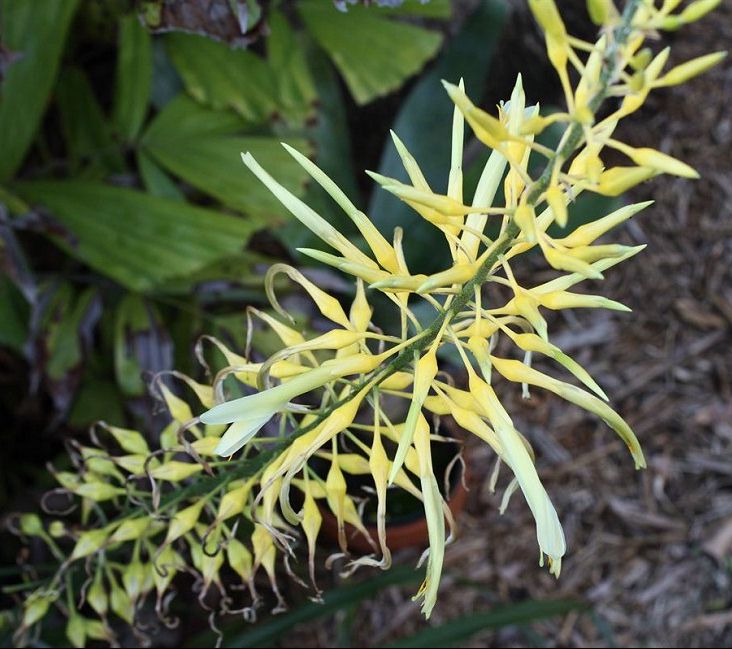
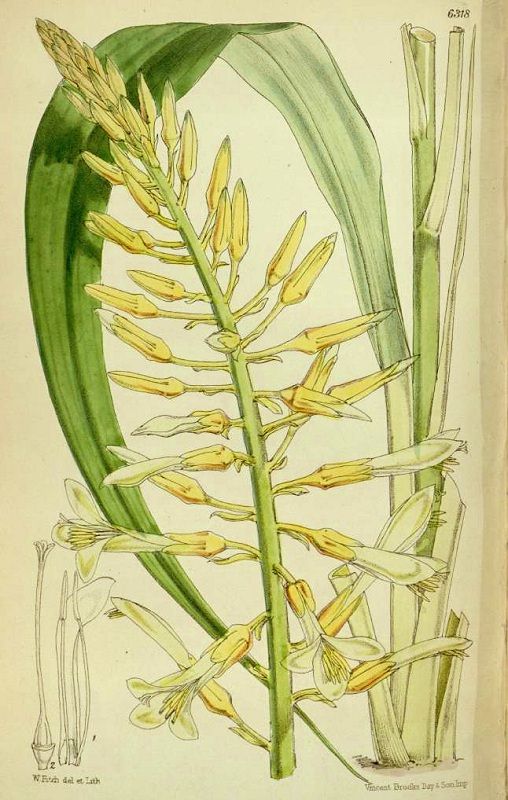
Pitcairnia xanthocalyx
Photograph (Left) by Nick Bethmann.
http://en.wikipedia.org/wiki/File:20100427_pitcairnia_xanthocalyx_.jpg
See article p.10, reprinted with permission from Jeff H. www.strangewonderfulthings.com/325.htm
April 2014


Pitcairnia xanthocalyx
Photograph (Left) by Nick Bethmann.
http://en.wikipedia.org/wiki/File:20100427_pitcairnia_xanthocalyx_.jpg
See article p.10, reprinted with permission from Jeff H. www.strangewonderfulthings.com/325.htm
NEWS IN BRIEF . . .
NEW MEMBER:
A very warm welcome to our new members Sandra Carnie and Pam Townsend who joined at our February meeting. We wish you both a long and happy association with our Society.
MONTHLY RAFFLE PRIZE ROSTER:
| Carmel Glanville, Anne-Marie Brun, Maadi McKenna, Maureen Wheeler | |
| Neville Wood, Max Williams, Sandra Southwell, Carole Taylor | |
| Laurie Dorfer, Lydia Chinnock, Eunice Spark, Warwick Varley | |
| Jan Stammers, Noel Kennon, Rena Wainwright, Carol Kerstholt |
WORKSHOPS:
The second of our three workshops for the year will be held on Monday, May 12th, at the Light Rail Museum, 48A Tongarra Road, Albion Park. The third, dealing with preparing plants for competition, will be held on Saturday, August 9th at Sharyn Baraldi’s home at 25 Antrim Avenue, Warilla [Phone (02) 4296 2166]. These have been very popular in the past and it is an opportunity for you to bring along any plants that you may be having problems with—or need an identity for—and also to meet and to chat with other members on a friendly, informal basis in a lovely garden/bush setting. The usual hours apply: from 10.00 am until 2.00 pm and anyone interested (particularly if you are a new member) is invited to attend. Bring your lunch—and something for morning tea would be appreciated—tea and coffee will be supplied.
VALE - JOHN CARTHEW
 |
It is with the greatest sadness that I report the death of John Carthew, who died quite suddenly on Sunday, March 23rd, but after a battle with ill health over the past couple of years. John and his wife, Carol, joined our Society in October 2004 and John was always the first one to put up his hand to help out with any jobs that needed doing, including as Vice President for a number of years (2008-2011) and President during 2011-2012. He was the sort of member societies would like to have more of--always willing to help even when he wasn't well; in fact his friend Neville remembers that he often had to make him sit down and take it easy. John will also be remembered for the most beautiful plants which he brought to our monthly competition tables, to our sales tables and to our Shows. John loved his family and his plants, being interested in African violets and orchids as well as bromeliads. He was very much a hands-on family man, very actively involved with his children, grandchildren, great grandchildren, and great-great grandchildren. He loved to play Santa at Christmas-time and was also very interested in their sporting activities. He particularly loved rugby league and, in his earlier days, worked with local children to get them interested in this sport. John, you will be sadly missed—and our thoughts are with Carol and your family at this sad time! |
GARDEN VISITS – SATURDAY, MARCH 15, 2014:
On the next page are pictures taken by Steve Wain in Steve and Edwina’s beautiful garden where lunch was supplied for our members.
Many thanks to Max and Helen, Ted and Sylvia, Steve and Edwina and Eileen and John who opened up their gardens on the day, March 15. About 30 members travelled ‘up north’ for this chance to explore the gardens and luckily the threatening thunderstorm held off until later in the day, although some folks, unfortunately, were caught in it on the way home! However, a day enjoyed by all!
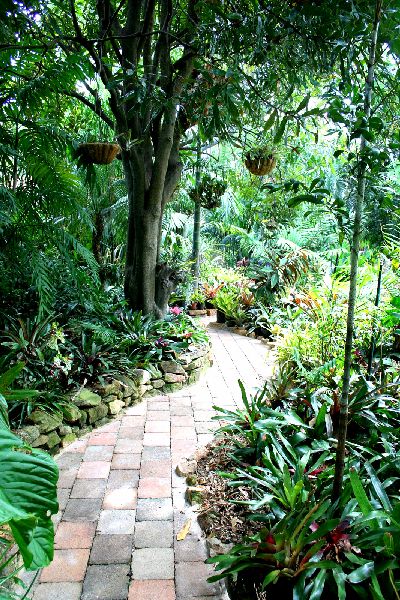

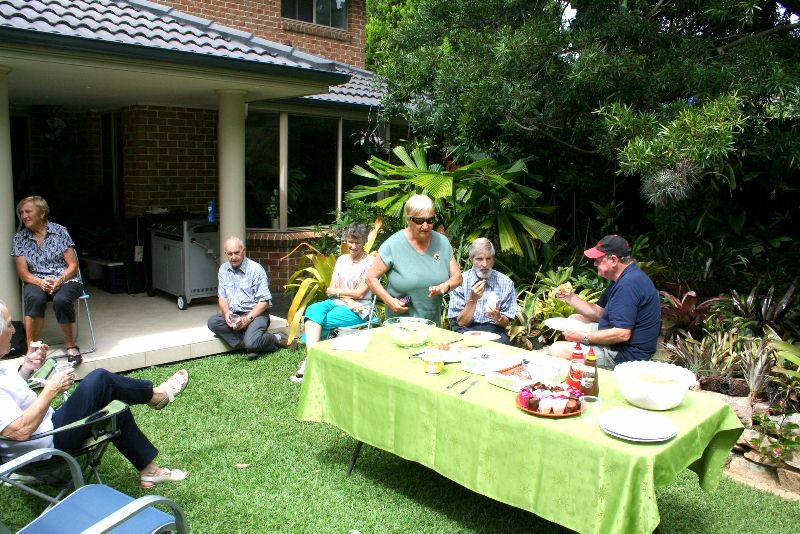
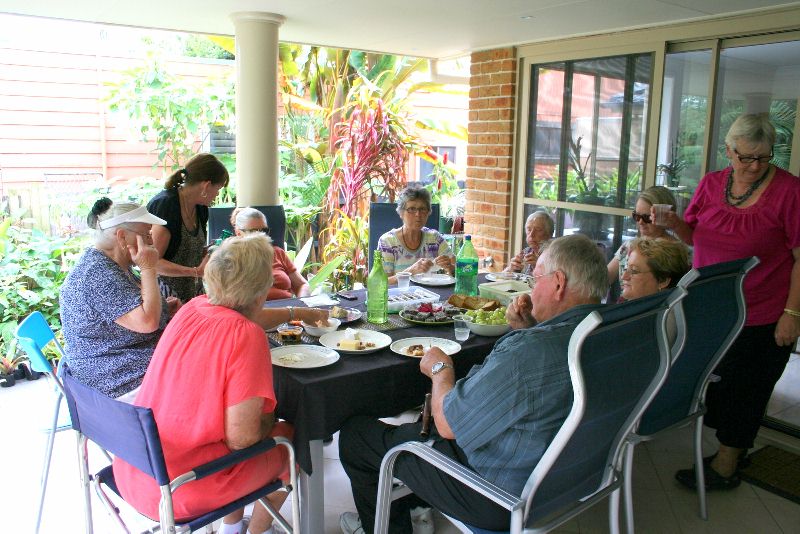
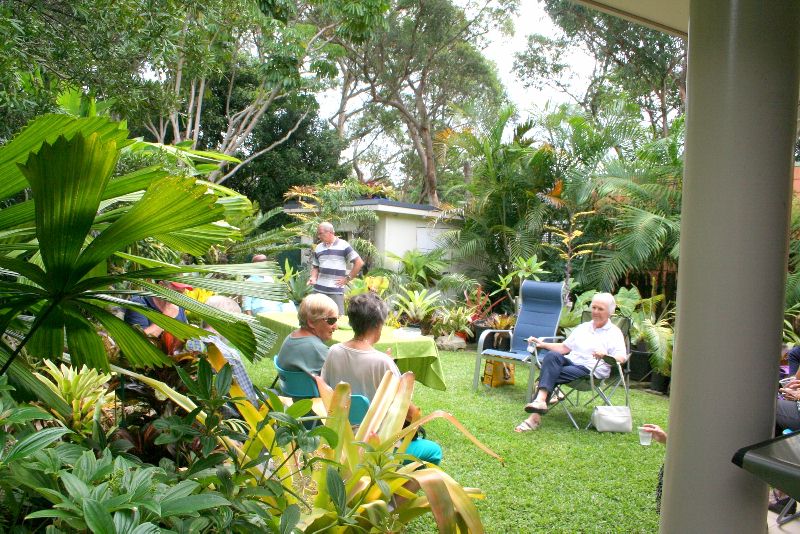
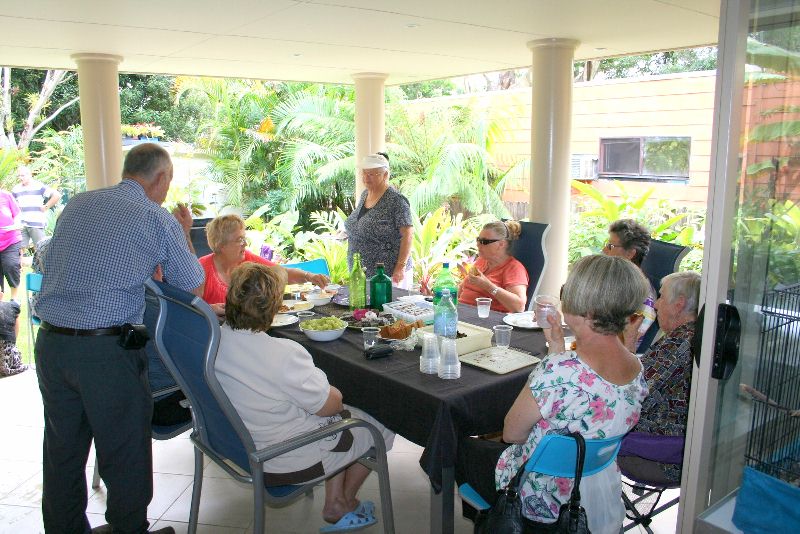

UPCOMING EVENTS :
| BROMELIAD SOCIETY OF AUSTRALIA – AUTUMN SHOW – BURWOOD RSL | |
| BROMELIAD FAIR – CONCORD SENIOR CITIZENS CENTRE, 9-11 Wellbank St. Concord. | |
| WORLD BROMELIAD CONFERENCE - BROMELIADS IN PARADISE – HONOLULU | |
| ILLAWARRA BROMELIAD SOCIETY SPRING SHOW – UNITING CHURCH HALL – Russell Street, CORRIMAL - 9.00 am – 3.30 pm | |
| BROMELIAD SOCIETY OF AUSTRALIA – SPRING SHOW – BURWOOD RSL | |
| 2015 |
BROMSMATTA – 18TH AUSTRALASIAN BROMELIAD CONFERENCE, NOVOTEL, PARRAMATTA. Hosted by The Bromeliad Society of Australia. Early Bird Registration before April 30, 2014 $260 pp. Reg.Form available on www.bromeliad.org.au |
NOVICE
1st = Max Williams = Hohenbergia correia-araujoi
2nd = Max Williams = Vriesea ospinae var. gruberi ‘Tiger Tim’
3rd = John Toolan = Billbergia vittata
TILLANDSIA
1st = Jan Stammers = Tillandsia leiboldiana
2nd = Jørgen Jakobsen = Tillandsia flabellata
3rd = Steve Morgan = Tillandsia duratii X stricta
March 1, 2014 PLANT RESULTS
OPEN
1st = Jørgen Jakobsen = Nidularium campos-portoi
2nd = Jørgen Jakobsen = Guzmania conifera
3rd = Yvonne Perinotti = Neoregelia Fosperior- ‘Perfection’
NOVICE
1st = Steven Dolbel = xNeophytum ‘Galactic Warrior’>
2nd = Steven Dolbel = Neoregelia ‘Wee Willy’>
SOME NOTES ON PLANTS BROUGHT TO OUR FEBRUARY/MARCH MEETINGS:
Neoregelia ‘Kiko’: John’s lovely plant is a fairly recent hybrid made by Lisa Vinzant of Hawaii who does some exquisite crossings. ‘Kiko’ is a cross using Neoregelia correia-araujoi as seed parent and N. olens as pollen parent. It was registered in 2007.
Vriesea ‘Tiger Tim’: Max’s lovely plant is a cultivar of Vriesea ospinae var. gruberi [native to Colombia], selected as a superior clone and registered [in 2003] by Peter Tristram. It is named for his son. Peter and Bruce Dunstan have done more work with ‘Tiger Tim’, coming up with at least another 3 beautiful cultivars which have been registered: V. ‘Sons of Tiger Tim’, ‘Scaredy Cat’ and ‘Smudge Grub’, all showing the greater mix of white in the leaves than the species V. ospinae var. gruberi. Vriesea ‘Tiger Tim’ is a fantastic plant; however it is cold sensitive. Peter’s advice to grow it well is to make sure the root system stays moist and that some K, Mg, Ca and a bit of P and trace elements are available (i.e., a big pot and a normal mix with a bit of food). There appears to be lots of seed-grown ‘Tiger Tims’ on the market at the moment, which have varying appearance, and do not match up to those produced vegetatively from Peter’s select clone.
Small Vrieseas: Laurie brought 4 beautiful examples of the smaller type vrieseas to our March meeting; these were all mounted and elicited admiration from many of our members.
• Vriesea scalaris [scalaris = ladder-like, referring to the placement of flowers on the stalk]: This is a dainty miniature with a small rosette—20 cm in diameter—soft, light-green leaves and a distinctive pendulous spike about 25-30 cm long, with flowers branching off left to right. The brownish-red floral bracts are shorter than the green sepals and this feature, and the smaller size, distinguish it from Vriesea simplex. It grows as an epiphyte in the shady forests in southern Brazil, usually at 1000 ft elevation [about 300 meters]. There are several forms of this vriesea: var. scalaris, which has bright red floral bracts with yellow tips; var. viridis, which has green bracts; and var. rubra, which has leaves that are suffused with red, faintly on the upper sides and strongly underneath. The petals are always yellow. Laurie reports that V. scalaris is easy to grow [prefers shade] and pups very well, while the flowers on his var. rubra seem to be larger than those on the straight species.
• Vriesea racinae [racinae refers to the discoverer of this plant, Racine Foster, who along with her husband, Mulford B. Foster, found this plant in Santa Teresa, Espirito Santo, Brazil in 1939 growing high on treetops at an altitude of 2,400 feet [around 730 m]: It is a miniature plant with numerous leaves forming a dense rosette, about 25 cm in diameter. The dark green, leathery foliage [10-12 cm long] has brown spots near the apexes and is brownish violet underneath; the leaves tend to curl. The 25 cm scape is slender and erect, bearing dark, spotted green bracts. The flowers, with greenish-white petals, have a slight fragrance that has been likened to both ripe apples and Ivory soap.( Padilla, Victoria. In: Bromeliads, Crown Publishers, Inc., New York) With its dark spotting, V. racinae will take extra sunlight and prefers a well-lit position. As Laurie noted, it has very big petals and a heavy inflorescence for the size of the plant.
Tillandsia-Like Vrieseas:
• Vriesea poenulata: Native to the states of Espirito Santo and Rio de Janeiro in Brazil where it grows as an epiphyte attached to rocks and trees. It looks like a tillandsia and can be cultivated either as an epiphyte or as a terrestrial in pots with good drainage. It grows to 30 cm tall including the inflorescence. It has many thin, recurved leaves growing from a modified-bulbous base. If kept fairly dry the leaves develop dark speckles which are attractive. Flowers are yellow and fairly large for so small a plant. The plant blooms regularly and produces pups well. [In the past had sometimes been confused with Vriesea flammea.]
• Vriesea plurifolia: There is little information that I could find on this interesting little plant but with its brown tomentose-like base [short hairs matted in appearance] Laurie was reminded of Tillandsia dura. Endemic to Brazil. Laurie gives his plant the same care as he does his V. poenulata.
PRECAUTIONS TO OBSERVE WHEN ACQUIRING A NEW PLANT
By Neville Wood, Illawarra Bromeliad Society, Inc.
Although these notes are written mainly for the new grower, some rules never change it doesn’t matter how experienced you are. When acquiring a new plant by whatever means, the underlying aim is to never compromise the integrity of the plants you already have by introducing some type of disease or insect pest into your collection. To avoid this, where possible it’s necessary to carefully inspect all proposed new purchases carefully to identify any problems. This is easily said, but for the new grower who has no prior experience and doesn’t know what to look for, it can be a daunting task. With these notes, which are based on my own experience of treating new plants, I hope to explain some of the things you need to look for when acquiring a new plant.
Initial Inspection
Basically, when a plant is offered for sale it should look at its best; if it looks untidy, has dirty leaves which are broken or cracked, dead flowers, or is in a dirty pot with the level of the potting mix lower than it should be, treat it with suspicion as this plant is suffering all of the classic signs of neglect. With the initial inspection of a plant, don’t just look at the flowers or the coloured markings on the leaves which may be what attracted you to it in the first place. Look past these things: look under the leaves as this is often overlooked but is an area where insect pests are often found; there should be no remnants of dead leaf growth around the base of the plant as this is a hiding place for various types of scale insects as well as mealybug and should have previously been removed.
When buying direct from a grower or a bromeliad society you are usually secure in the knowledge that most growers will give you sound advice and replace a plant if found to have a problem. It’s when you buy plants from other sources that you have to be on your guard. A lot of general nurseries, large department stores and combined hardware/nursery businesses also sell bromeliads; however they are rarely the growers, but are just “on sellers” and very often the person doing the selling has very little (if any) knowledge about the cultural requirements of these plants. The other thing to consider is that plants bought from these types of businesses are often neglected and left sitting inside on a shelf, or outside sometimes in unprotected full sun waiting to be sold. Sometimes they are in this situation for many weeks and often without water. This type of treatment can stress a plant and affect its health. Often plants bought from these businesses are unnamed or occasionally will have a “generic name tag” informing you that the plant is a “Bromeliad” and provides some basic cultural information on the back of the label in a “one fits all” format, which we know is wrong for a start as different genera of bromeliads have different cultural requirements.
When you are first attracted to a particular plant, have a good look at the “total plant”, not just the flowers or the coloured leaves but look at everything. Don't just concentrate on the obvious; be critical, be a “nit-picker” and look for any possible problem/s at all. Generally speaking the plant should look clean with strong leaves and be firm in the pot. Beware if the leaves are droopy, yellowing or have dead tips as these are all signs of possible problems. If the central leaves are yellowing this could indicate that the plant has crown rot and if you smell the centre of the plant you will know immediately as the smell of crown rot is a terrible smell you’ll never forget.
Feel the weight of the plant and pot; if it feels abnormally heavy it’s possible that the mix is poorly drained and is water-logged: if it appears unusually light, it may have been starved of water for a considerable time which could cause the plant to be in the early stages of dehydration. Bits of dead leaves around the base of the plant demonstrate that the grower of the plant wasn’t too fussy about plant hygiene and indicate the possibility of other hidden problems. If you are in any doubt about the plant’s condition then don’t buy it, it’s as simple as that.
What To Do With A New Plant When You Bring It Home
For the most part, bromeliads are rarely troubled with serious diseases or insect pests; however once you have bought, swapped or been given a new plant as a gift, it’s a good idea to keep it separate from other plants in your collection. In other words, quarantine it just in case it may have some type of disease which isn’t yet obvious. By following a firm rule of keeping all new plants quarantined you are protecting your other plants and preventing the introduction of possible disease or insect pests.
Different growers follow different approaches at this point: some can’t be bothered to take the precaution of quarantining a new plant and just take a chance and add it immediately to their collection. Others will quarantine a plant and adopt the “watch and wait” method to see if any problems develop and then treat accordingly. Personally I like to take the preventative route, and although I don’t advocate spraying poisonous substances over whole collections on a regular basis like some growers do, I have no problem treating individual plants with a fungicide or systemic insecticide if there is evidence to suggest the plant requires it.-
Once the plant is removed from the pot, look at the state of the potting mix: is it excessively wet or dry? This may explain why some of the leaves look like they do--e.g., brown leaf tips often mean not enough water while yellow leaf tips mean too much water. Examine the roots themselves and remove any that are dead.
The next step is to look for evidence of insects or other creatures that may cause problems
The main problem to look for around the roots is “Root Mealybug”. This is an insect which does its damage unnoticed beneath the surface and is similar in appearance to the mealybug we occasionally see which is usually covered in a white woolly substance [refer to article on these types of pests in the January 2014 Newslink]. It likes dry conditions and is sometimes seen when we remove remnants of dead, dry growth from the base of a plant. Root mealybug may attack any roots but prefer the dryer areas of the mix just below the level of the soil, especially where the root and the stem meet. Although they can occur throughout the whole root system, they are most obvious around the edges, and can sometimes appear on the inside walls of the pot. Even if they can’t be seen, evidence of their presence is often seen as a fine white coloured web on the inside of the pot. Root mealybugs are sap-sucking insects, and it’s this that causes the problem as they weaken the plant by sucking the sap while working beneath the surface of the mix and out of sight.
Precautionary Treatment
The plant is then moved to a semi-shaded area where it is thoroughly watered the next day. It will remain there for a week, after which time the light level is gradually increased over a period of a month. Even though leaf colour is a good indicator of what light levels the plant was previously exposed to (with light green leaves suggesting high light and very dark green leaves suggesting low light), it’s not often that you will definitely know the plant’s previous growing conditions, and as a precaution it’s far better to increase the light gradually to be on the safe side. Under no circumstances should you put a newly introduced plant in direct sun.
Transport Considerations
If plants are being sourced from tropical areas such as Far North Queensland, it’s not a good idea to buy them during our winter where they will be coming from a hot tropical environment to our cold winter. If this is the case the difference in temperature will stress the plants somewhat and it will take possibly twelve months for them to become fully acclimatised to our conditions. During this period while they sit in dormancy they are more prone to fungal attacks which may cause rot. It’s far better to purchase them in the middle of summer when the temperature difference isn’t so great and plants are actively growing. Also, plants coming from tropical areas are sometimes carrying “Flyspeck Scale” or its eggs as this pest is prevalent in the warmer tropical climates, so be vigilant when checking your new plants from northern areas.
There are other risks when plants have to come by air from interstate and these can be the effects of excessive heat or cold. Sometimes plants can be left sitting out in the hot sun for long periods, resulting in them being “cooked” if they aren’t packed correctly: in fact you will get the same result as you would if you left a plant in the boot of a car during a hot day.
Likewise, if they are in a plane cargo hold which isn’t pressurised, the temperature at high altitudes can sometimes fall below zero and if they aren’t completely dry, they may suffer damage from the extreme cold. I have only ever had one problem with mail order plants and that was when a nursery sent plants that had been wrapped while they were still partially wet. When they arrived they had scald-type marks on the leaves which I suspect was a result of exposure to extreme heat. The best insurance against this is to stipulate that you want the plants packed in a polystyrene box as the extra insulation will offer the best protection possible against excessive heat or cold.
If you do receive plant/s that have suffered damage of any kind, immediately contact the seller, as any reasonable seller will usually replace the plant or compensate you in some way. In my case (mentioned above), I immediately sent the nursery an email with accompanying pictures of the damaged plants and had an answer within the hour and replacement plants were sent the next day. The owner admitted liability stating the plants had not been thoroughly dry when wrapped.
When new plants arrive, you must consider they have been wrapped up and confined in an unnatural and cramped position for often 3-7 days, and even with careful packing they will still be somewhat dehydrated. The leaves will appear compressed into an unnatural shape where they have been confined for so long and look much like a butterfly’s wings as it emerges from its “cocoon” for the first time. To quickly rehydrate these plants and help the leaves regain their original shape, I stand the whole plant for a couple of hours in a sugar/water mix at the ratio of one cup of sugar to one bucket of tap water. I occasionally immerse the whole plant and pour some of the liquid into the central vase of the plant. After this they are then treated as mentioned above in “Precautionary Treatment”.
Having followed the above precautions, you can rest assured you have treated your new plant to the best of your ability and it should quickly progress and re-establish itself in its new environment. If at any time you don’t think a plant is performing to expectations, don’t be frightened to ask for advice from other growers as I’m sure they will be only too willing to help.
Pitcairnia xanthocalyx is an attractive bromeliad from Mexico with some unusual qualities. Unlike many bromeliads, which have stiff or painfully spiny leaves, its foliage is smooth and grass-like. And unlike most pitcairnias, which have red flowers, its tall bloom spike is a showy yellow. This is one of the easier bromeliads to grow, thanks to its tolerance for wet soil.
The plant forms an attractive rosette of leaves about two feet all, which could be mistaken for an oversized grass. It multiplies readily by underground rhizomes, eventually forming a large family of plants. It’s easily grown in a pot, and flowers at a young age. The 2-foot tall flower stalk is lined with dozens of tubular yellow and white blooms. The plant may be hybridized with some other pitcairnia species to create new varieties.
It tolerates a wide variety of temperatures, reportedly handling the low 20Fs (-60C) as well as high heat. It is happiest in part sun, with some protection from strong afternoon sun. It prefers well-draining, fertile soil that’s kept evenly moist. Avoid letting it dry out completely. In the right conditions, it is an easy and care-free plant.
AN INTRODUCTION TO PITCAIRNIA
Classification
A Unique Bromeliad
Characteristics
Pitcairnias also often send up tall, brightly coloured flower stalks. The flower stalks usually produce thin, tube-shaped flowers that project at right angles from the stalks. Flower stalks and flowers are typically found in pinks, red, oranges and occasionally in yellows and whites. Many pitcairnias are notable for their long-lasting inflorescence. They usually set blooms in early summer [mid June in the northern hemisphere] and can last through late fall. In some cases the plant will maintain its inflorescence until November.
Care and Uses
Pitcairnias also make excellent indoor plants. Depending on the species they prefer to be kept moist, but not soggy. Like most bromeliads, pitcairnias can be susceptible to root rot when their potting medium remains too wet. Use a well-draining potting mix. You can purchase potting soil formulated specifically for bromeliads or you can mix your own, using half regular potting mix and half perlite.
Many pitcairnias will do well in dappled shade to full sun. Some species prefer humid environments and may require regular misting when grown indoors. Many can be grown in pots as small as six inches. Pitcairnias will produce offshoots or pups. The pups can be removed and planted separately or allowed to grow in clumps attached to the mother plant. If you desire to let the plants grow in clumps, you will want to use a slightly larger pot. You will need to separate and repot the plants once they become too pot bound.
Species
Pitcairnia undulata is very unique from other pitcairnias and from other bromeliads. Unlike most bromeliads, this species grows very broad leaves on petioles or stems. The leaves are discolor, with dark green on top and silver on the undersides. It produces a long-flowering, simple red spike. This plant generates pups easily and forms clusters that reach two feet wide and up to 30 inches tall. Pitcairnia undulata would make a very beautiful indoor plant.
The Pitcairnia genus is named after a London doctor, Pitcairn. The genus can be found from southern Mexico and the West Indies down to northern Argentina and Peru. Most species are found in Brazil, Colombia and Peru. The only bromeliad species whose native habitat is outside of the Americas is a pitcairnia, namely P. feliciana, which grows on cliff faces in tropical West Africa.
Many botanists argue the genus Pepinia should be included in the Pitcairnia genus. However, in this article the distinction has been maintained. There are over 250 species in these two genera.
Most pitcairnias and pepinias are grass-like plants that grow in the ground (terrestrials) or on rocks (lithophytes). A few are epiphytes. Most grow in moist, shady locations. Typically they form a clump that develops through underground rhizomes.
The leaves of many pitcairnias and pepinias are spineless, while those plants with spines generally have small ones.
These plants’ leaves are quite variable in length and shape. Some have several types of leaves on the one plant. Perhaps the most graphic example of this variation can be found in “deciduous” species such as Pitcairnia heterophylla. In that species, the “normal” leaves drop off at the start of the dry season to help the plant conserve moisture. The short brown “spikes” that remain are a primitive type of leaf that contains no chlorophyll.
Pitcairnias and pepinias can be propagated easily either from seed or, for many species, by detaching a piece of the underground rhizome (taking care to obtain a piece with roots attached). The underground rhizome can be severed by either using a knife or, in some cases, a spade! Other pitcairnias and pepinias form bulbous-like growths that can be broken apart to provide new plants.
These plants will thrive if grown in a mixture similar to that used for most indoor plants. A mixture which has given good results for myself is comprised of 1 part Cocopeat or peat moss to 1 part of coarse sand. A continuous release fertiliser, such as Osmocote, should be added to the potting mixture in the concentrations recommended by the manufacturer for indoor plants.
Repot the plants once a year. They typically like bigger pots for their size than other bromeliads. For example, a single offshoot of many species can often be grown into a small clump that requires a 250 mm bucket within 30 months. Plants should be watered until water starts to flow through the pot’s base, at least three times a week in summer. Twice a week in winter should be adequate, except during periods of low humidity.
These plants’ leaves generally do not suffer from insect attacks although grasshoppers can attack young leaves on rare occasions. However, aphids can cause significant damage to flowers.
Pitcairnias and pepinias will grow well under 50% shade cloth in winter and 75% for the rest of the year. They also thrive in shaded (but well drained for virtually all species) areas in the garden, but are unlikely to do well in situations that receive the full afternoon sun (especially in summer).
When grown in the ground, pitcairnias’ relatively tall (usually 50 cm or more), green, grass-like foliage can form an effective “backdrop” to a planting in front of them, comprised of their more colourful bromeliad brethren--for example, neoregelias.
The ancestors of many of the plants currently grown in Australia were obtained by growing plants from seed obtained from overseas. While many interesting plants were obtained, unfortunately it has become obvious that quite a few are incorrectly identified.
While there are few named pitcairnia and pepinia hybrids, it is possible many of the ”species” grown in Australia could be hybrids. Alternatively, some species are much more variable in appearance than is commonly believed.
Pitcairnias and pepinias are not readily available. However, you should be able to build up a collection of 10 or more species over a period of several years by searching for them at the Society’s field days, monthly meetings and shows, and asking bromeliad nurseries. If you are willing to settle for a rhizome with a few leaves and roots attached, rather than a well-established plant in a pot, then you are in the best position to quickly build up your collection.
THE UNRULY PITCAIRNIAS
Every family has a horse thief somewhere in its past. In fact, for many families horse thieves make up one or more branches of the family tree. In my family, they probably make up the whole damned canopy, but the point is that no family is without the occasional outsider who refuses to conform to the traditions held by the rest of its members—an outlaw who refuses to behave like very other member of the family, and so it is with bromeliads. The recalcitrant member of this otherwise stable family is the genus Pitcairnia. Pitcairnia, and its unruly brother genus, Pepinia, do not follow the rules that “everyone knows” apply to bromeliads. This in spite of the fact that Pitcairnia is one of the first bromeliad genera to evolve.
“Prove it”, you say! Let’s just cite some examples:
1. Maple trees are deciduous, grape vines are deciduous, tulips are deciduous, but “everyone knows” that bromeliads are not deciduous. Someone needs to explain that to the small group of pitcairnias which annually shed their leaves to get through the dry season.
2. “Everyone knows” that a bromeliad leaf consists of a blade and a sheath. No-one looks at a bromeliad expecting to see a leaf with a petiole. Yet some of the pitcairnias can’t even seem to get this simple morphological adaption right.
3. The family Bromeliaceae is restricted to the western hemisphere—every member of the family but one species is found there. Care to guess which genus includes the solitary outcast?
4. “Everyone knows” that one of the main characteristics for sorting out the three subfamilies of Bromeliaceae are the presence or absence of spines on the foliage. The subfamilies Bromelioideae and Pitcairnioideae have them. Tillandsioideae does not. Leave it to Pitcairnia to disrupt this comfortable scheme by some of its members having both types of leaves—spiny and spineless—on the same plant. Some even have spines at the base of the leaf but none along the blades.
5. “Everyone knows” that bromeliads do not like to be overwatered or grow in soggy soil. Yet there are pitcairnias growing in the wild in what can only be described as sopping wet conditions.
6. Bromeliads, like orchids, are the subjects of rampant if not random hybridizing. Hybridizers can’t seem to pass a pair of blooming bromeliads without wondering what the offspring between them would look like. For example, there are only about 40 species of Cryptanthus, but there are close to a thousand hybrids and cultivars listed, the differences between some of them so small that “subtle” would be too strong a word to use in describing them. There are less than 100 Neoregelia species described, but there are 100 pages of hybrids and cultivars (about 21 plants per page) listed in Don Beadle’s Preliminary Listing of All Known Cultivar and Grex Names for the Bromeliaceae. Therefore you would expect a huge genus like Pitcairnia, second only to Tillandsia in the number of species in the bromeliad family, to have been hybridized and ‘cultivared’ to high heaven, wouldn’t you? Beadle lists eleven hybrids and no cultivars.
7. Another compulsion of hybridizers is the creation of bigenerics. There are a lot of horticultural Doctor Frankensteins among hybridizers who are bent on creating new life forms, even if some of them do turn out to be monsters. Navia is the genus closest to Pitcairnia, hence it is the most likely candidate for bigeneric dallying, but have you ever heard of an xNavcairnia? If even the hybridizers ignore a genus you know it must be a disreputable one.
8. That bromeliad growers will collect almost anything is apparent by the fact that some of those bigenerics remain in collections. Why in the world would anyone want to grow a xNeomea ‘Nebula’ for example? Still, as indiscriminate as we bromeliad collectors often are, do you know anyone who has as many as six of the 320 or so species of Pitcairnia in their collection?
Not only are pitcairnias and pepinias a primitive bunch, but, as shown above, they are also an unruly one. For the sake of simplicity, in this discussion no distinction is made between the genera Pepinia and Pitcairnia. They both were formerly included as subgenera of Pitcairnia, but recently Pepinia has been elevated to the status of genus. However, I might add that in his introduction to the Alphabetical List of Bromeliad Binomials, Harry Luther remarks, “Nomenclatural problems continue to plague the resurrected genus Pepinia. A number of taxa that appear to belong in Pepinia have never been formally transferred from Pitcairnia.”
Why doesn’t that surprise me?
THE SEASICK TILLANDSIA
In tracking down the origin of names of bromeliad genera it does not take long to find out that Linnaeus named Tillandsia after Elias Tillands, a professor at Abo in Finland. There most references stop, but look at page 42 of an old volume with this awesome heading: "Lachesis Lapponica or A Tour in Lapland, now first published from the original manuscript journal of the celebrated Linnaeus; by James Edward Smith, M.D., F.R.S., etc., President of the Linnaean Society, 1811."
It reads as follows: “The greater part of my way lay near the sea shore, which was bespread with the wrecks of vessels. How many prayers, sighs and tears, avows and lamentations, all alas in vain! arose to my imagination at this melancholy spectacle.” It brought to my mind the student, who in going by sea from Stockholm to Abo had experienced so severely the terrors of the deep, that he rather chose to walk back to Stockholm through East Bothnia, Tornea, West Bothnia, etc., than trust himself again to so cruel and treacherous a deity as Neptune.
This was Tillands, afterwards Professor at Abo, who hence assumed this surname, expressive of his attachment to land, and Linnaeus named in honour of him a plant which cannot bear wet. See his Ord. Nat. 291—[This] Ord. Nat. reference proves to be a paragraph in Latin giving the more definite information that Tillands chose two hundred miles by land rather than eight by sea. Linnaeus had his little joke on his seasick friend but he showed himself a poor observer, for he should have noticed that the scales of Tillandsia function like blotting paper and not like shingles as he evidently imagined.
You are only able to “half examine” any plant at the point of purchase because to examine a plant thoroughly you must knock it out of the pot so that the roots can be examined just as closely as the foliage. I shall call this the secondary examination and this takes place when you get the plant home.
--e.g., worms may block up the drainage holes with their droppings as they break down the potting mix, but this is mainly apparent when the pots have been sitting directly on damp ground. By simply repotting the plant and relocating it to a position up off the ground you can rectify this problem.
When I acquire a new plant, it doesn’t matter what its condition is like or where it came from: all new plants get the same precautionary treatment, because even with no evidence of any insects there can still be eggs which need to be dealt with and nullified. I remove as much of the old potting mix as possible and thoroughly hose off any remaining mix not adhering to the roots. I then mix up a reliable systemic insecticide in a container large enough to accommodate the whole plant and completely immerse the total plant for at least half an hour and until air bubbles can no longer be seen rising to the surface which indicates there are no air pockets preventing the insecticide from contacting the whole plant. I then hang the plant upside down and allow it to air dry after which time it’s re-potted in my own fresh, damp potting mix.
I now want to suggest some things you should consider when buying plants by Mail Order from outside of the local area. These plants will have to be sent by Australia Post or some other courier service which usually requires a combination of road and air transport, depending on where the plants are coming from. I, personally, always use Australia Post which is a combination of air and road transport and as far as delivery times go I find Australia Post as good as any other courier service and better than most.
COVER PICTURE: PITCAIRNIA XANTHOCALYX
(Reprinted with permission from Jeff H.,
By Melanie Dearringer. Reprinted with permission from author at: http://www.bromeliads.info/an-introduction-to-pitcairnia/
Pitcairnia is one of the largest genus of bromeliad plants. It includes 391 different species and is second only to Tillandsia for number of species within the genus. Pitcairnias are typically found in South American highlands and range primarily within Brazil, Colombia and Peru. However, they can also be found in a few other places throughout South and Central America.
Pitcairnia also has the unique pleasure of boasting the only species in the entire bromeliad family that is not native to the new world. Pitcairnia feliciana makes its home in West Africa. It is suspected that the plant found its way to Africa through seed dispersal by migratory birds. The species is small, with very thin, sparse leaves. The leaves have a few spines that increase towards the centre of the rosette.
Pitcairnias are primarily terrestrial and saxicolous, meaning they grow either in the ground or attached to rocks. There are a few species that can also be found growing as epiphytes in trees. Pitcairnias are characterized by softer, drooping leaves, a few of which have spines, while others remain spineless. This is opposed to many other genera of bromeliads that have stiff leaves.
Pitcairnias are native to generally mild climates. They can be found in humid rain forests and more arid highlands. They usually prefer moderate temperatures, ranging around 80F [~27C]. They can handle a bit of frost if protection is provided. Pitcairnias can be excellent bedding plants in temperate climates. Some look similar to ornamental grasses when not in bloom and are stunning once the inflorescence grows. They can easily form thick mats and borders.
There are many species of Pitcairnia that are available for growth in cultivation. They are difficult to find in conventional nurseries and garden stores, but are easily ordered online or found in speciality tropical plant retailers.
GROWING PITCAIRNIAS AND PEPINIAS
By Bob Reilly. (Extracted from Bromeliaceae, J. Bromeliad Society of Q’ld, Volume XXXIX No. 3, May-June, 2005)
By Chet Blackburn
(Reprinted, with editorial comment, from Bromeliaceae, J. Bromeliad Society of Q’ld, Volume XXXIX No. 3, May-June, 2005, in turn reprinted from J. Bromeliad Society, 1997, Vol. 47(1). In this article, Chet Blackburn, who was the Journal’s editor at the time, takes a light-hearted, but insightful, look at some of the peculiarities of the Pitcairnia/Pepinia genera.)
By Lyman B. Smith [Taken from Journal of the Bromeliad Society – Volume 1, Number 4]